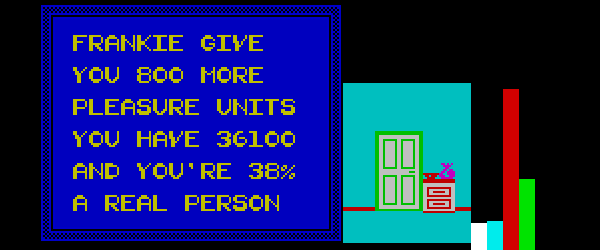
On Rock Paper Shotgun, an essay about the "bizarre, ambitious Spectrum game/band spin-off Frankie Goes To Hollywood – a game of pop music, terraced houses, sperm, Nazi bombers, Reagan spitting at Gorbachev and murder most foul." (via things magazine) Rachel Lord writes about the history of khaki for DIS magazine, "khaki was a Victorian military breakthrough. A technology, first and foremost, that gave the “Informal Empire” of Great Britain her second wind... When confronted with the realities of non-conventional, guerilla-style warfare in harsh climates against an ever-changing enemy, their primary issue was their inflexibility." "Instagram is all about death. The 70s filters our parents used, artifacts of cameras we’ve never held. Nostalgia is the negation of death, it proves we are still living even without an identifiable future. Instagram is a machine for producing instant nostalgia, a ward against death...We are told that digital (over)sharing on social networks and the like is a natural human impulse, that we’re merely augmenting extant human needs, the need to communicate, to form social groups. But what if sharing is actually a mourning for what we have lost? Or, that which our lives are now too full to contain."- James Bridle Geoff Dyer's first column for the NYT on recursive summarizing in an academic book, not unlike "watching a rolling news program: Coming up on CNN . . . A look ahead to what’s coming up on CNN." Hito Steyerl, Right in Our Face (e-Flux) The fact is that if I've learned one thing in two years of studying how we think about the future, it's that the one thing that's sorely lacking in the public imagination is positive ideas about where we should be going. We seem to do everything about our future except try to design it. It's a funny thing: nobody ever questions your credentials if you predict doom and destruction. But provide a rosy picture of the future, and people demand that you justify yourself. - Karl Schroeder writing for Charles Stross's blog Cat Vincent looks at films from "The 'Your Reality Isn't Real' Boom of 1999" Douglas Rushkoff interviews Genesis P‑Orridge in The Believer Charles Holland considers Iain Sinclair's problematic recent writing about the London Olympics, "[There] are strong arguments to be made about the economic and political effect of the games and Sinclair isn't really making them. Instead he offers anaestheticised vision of, for want of a better term, shittyness. At one point during his film he pointed to a breakers yard and declared it as good as a Joseph Beuys artwork. This is the urban hipster version of shabby chic, an effete observation that recalls the British painters of Saint Ives patronising (in every sense) Alfred Wallis." "I have what's called a pattern brain. I pattern music together and I pattern ideas together, sometimes it works and sometimes it doesn't. What I'm intrigued by more and more is that increasingly we live in an emotional time, and people pattern in a much more emotional way than they used to... And the collage with music, they're much more open to that." - The Wire interviews Adam Curtis Germaine Dulac's The Seashell and the Clergyman (1923,) the "first surrealist film." Archiving as Presentation. Notes from a recent Warhol Initiative session on ways to "negotiate this tension [between memory and forgetfulness] through archival practices and methodologies that approach the archive as more than just a static repository of past productions." Mark Changizi: The secret sauce in language and music (Wired UK) A quick summary of findings in his upcoming book, "The fundamental auditory constituents of solid-object events are hits, slides and rings (periodic vibrations of the objects involved in hits or slides), and we find the same three 'atoms' in speech: plosives, which sound like hits (t, d, p, etc); fricatives, which sound like slides (f, v, sh, etc); and sonorants, which sound like rings (like a, u, w, r, y, etc)..solid-object events have an identifiable 'grammar' of sorts, one that also appears in the patterns across human speech from diverse languages." This American Life Episode 441, "When Patents Attack!" Music video for "Everytime" by Oi Va Voi The whole issue of digital is so depressing to me; my process is gone. There were all kinds of unknown things that could come out in a photograph, things you didn't know were there until you saw it; now it's all so flat. But then I never really saw myself as a photographer. - Nan Goldin in The Guardian

